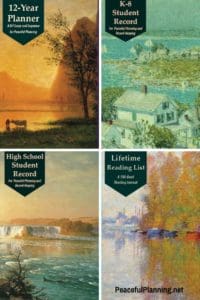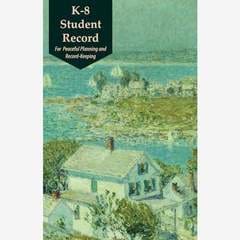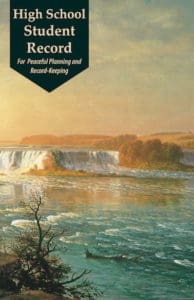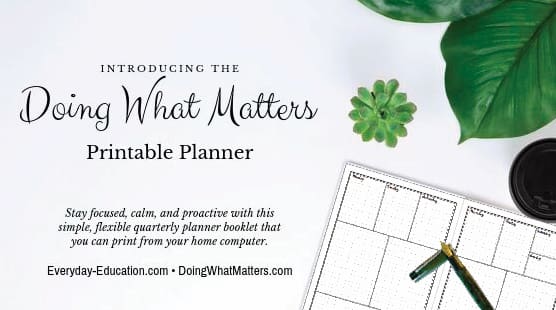The Peaceful Planning System
Peaceful Planning helps you focus on things that matter.
 Many years of teaching and learning taught me that homeschool planning and record-keeping tools had to be simple and streamlined, and (preferably) easy to carry. The Peaceful Planning system closely resembles the simple records I created when we were homeschooling except that the original versions were hand drawn in a notebook. I hope you'll find these little booklets a helpful tool for peaceful planning.
Many years of teaching and learning taught me that homeschool planning and record-keeping tools had to be simple and streamlined, and (preferably) easy to carry. The Peaceful Planning system closely resembles the simple records I created when we were homeschooling except that the original versions were hand drawn in a notebook. I hope you'll find these little booklets a helpful tool for peaceful planning.
What you need for you
High School Requirements Worksheet (PDF)
12-Year Planner booklet (for you)
1” binder (for you)
Calendar or Personal Planner
What you need for each student
1 K-8 Student Record and/or High School Student Record booklets
1 Personal Reading Log or other reading journal
1 expandable pocket folder (2” size works well)
1 large 3-ring binder with tabs (the 12-year cumulative record)
[Links to binder and folder examples are affiliate links, of course; see details at the bottom of each page.]
The first year planning process
Before the school year starts, set aside a planning week or weekend (a quiet getaway is ideal, but not always doable).
- Outline a bird's-eye view—begin drafting a plan in the 12-Year Planner.
- Photocopy or print out the table of contents from each of your resources and add to the Teacher Plan binder.
- Have ready a pocket folder and 3-ring binder for each student's cumulative work samples.
- In each student’s Student Record, note the subjects, books, and resources your student will use throughout the year. .
- During the year save work samples as recommended below.
- At the end of the year, empty each student’s pocket folder; add representative samples to the cumulative binder; look over the Personal Reading Log; and write progress notes in the Student Record. This should not take long, because you are working within a manageable structure and haven’t kept too much stuff (that's a major principle of Peaceful Planning!).
- In the K-12 Planner, pencil notes about any changes you made.
- Make a list of things you plan to get for the coming school year.
- Celebrate!
The second year and beyond
After the first year, the planning process will be shorter, as the K-12 Planner is already filled out, and you can re-use your planning binder and student folders indefinitely. You will end up doing numbers 1, 3, and 5-10 each year, and it will become simpler and smoother every time you do it. When your student reaches high school, you will continue the same process, and use the High School Record to create a transcript (Transcripts Made Easy can help with the mechanics of making the document). Planning truly can be peaceful!
Make a simple plan
12-Year Planner: the bird’s-eye view
 Using the 12-Year Planner, sketch out an overview of what you plan to cover each year. Use a pencil, as this is the draft of a plan — not a record. As you work through each year and see which resources work well, you can write them in more permanently. For now, this is just a working document that will help you see the big picture of what you plan to cover and when it will happen.
Using the 12-Year Planner, sketch out an overview of what you plan to cover each year. Use a pencil, as this is the draft of a plan — not a record. As you work through each year and see which resources work well, you can write them in more permanently. For now, this is just a working document that will help you see the big picture of what you plan to cover and when it will happen.
If you are just beginning, don’t feel as if you need to fill out the whole thing at once. It is intended to be something that you add to and update throughout the homeschooling years. If you already partway through the homeschool journey, just note what you’ve already done, and sketch out what needs to be done in the remaining years. This simply means identifying what areas of history, literature, science, math, and the arts you will cover in each year. Doing this will help you create an overall plan that not only meets requirements, but will also prepare your student for the next stage of life.
Working Yearly Plan binder: the treetop view
As you look forward to each new school year, photocopy or print from online the table of contents from each major resource you plan to use. Use a highlighter or pencil to note which chapters or lessons you plan to cover. Place these in the Yearly Plan binder.
Daily calendar/planner: ground-level view
On your personal planner (here's the planner I have used for years) or wall calendar, pencil in the range of lesson or chapter numbers you hope to do each week or month. I would suggest that planning four school days worth of lessons is probably realistic, even if you teach for five days. You are teaching children, not books, and it sometimes takes longer than a day to fully understand a concept or complete an assignment.
Keep simple records

A 2” pocket folder is usually adequate for one year's worth of classes, but they are available in sizes up to 3.5” deep. To keep your record-keeping simple, remember the Peaceful Planning suggestion to save just enough so that you're not overwhelmed with too much stuff when it is time to add notes to the student record booklets.
Student Record booklets
 At the beginning of the school year, use the appropriate Student Record booklet to briefly record what the student will be studying—including primary books, curriculum, and activities. If you’ve filled out the 12-Year Planner, you can simply transfer basic information to the Student Record, and add additional details.
At the beginning of the school year, use the appropriate Student Record booklet to briefly record what the student will be studying—including primary books, curriculum, and activities. If you’ve filled out the 12-Year Planner, you can simply transfer basic information to the Student Record, and add additional details.
At the end of each semester or year, sort and review the work samples in the student’s folder. Write a few brief progress notes for each subject on the Student Record, and for high school Class Profiles, add the date the course was completed and a grade.
Keep a 12-year cumulative student record
 You will need a large binder for each student, as this will become an easy-to-reference cumulative file. It will contain representative work samples, and the Student Record booklets can be stored in the inside cover pocket. Tab numbers correspond to grades, and the extra tabs can be used for things like book lists, standardized test results, or copies of any official documentation you are required to file for your student.
You will need a large binder for each student, as this will become an easy-to-reference cumulative file. It will contain representative work samples, and the Student Record booklets can be stored in the inside cover pocket. Tab numbers correspond to grades, and the extra tabs can be used for things like book lists, standardized test results, or copies of any official documentation you are required to file for your student.
Returning to the work samples in the folder, choose 2-3 from each subject, and add to the cumulative binder behind the tab that corresponds to the student’s grade. You’ll have 12-18 samples from each year, which should provide a simple overview of educational progress. If you prefer to keep the record digitally, just scan the chosen samples and save to a file in the Google Drive or Dropbox. If you want to create a really interesting souvenir of your student’s work, bind it into a paperback or hardbound book. If nothing else, it will amuse your grandchildren when they reach school age.
- K-8 Student Record
- High School Student Record
- Personal Reading Log: 100 Books to Remember *
- Doing What Matters Printable Planner
(*This used to be called the Lifetime Reading List.)
- The binder and pocket folders links point to Amazon, and are affiliate links (see footer for complete information on these).

I loved hearing you speak at the GHC online. You are by far my favorite speaker.
Do you offer homeschool consultations?